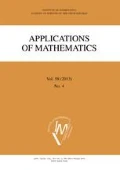Abstract
The paper is concerned with guaranteed and computable bounds of the limit (or safety) load, which is one of the most important quantitative characteristics of mathematical models associated with linear growth functionals. We suggest a new method for getting such bounds and illustrate its performance. First, the main ideas are demonstrated with the paradigm of a simple variational problem with a linear growth functional defined on a set of scalar valued functions. Then, the method is extended to classical plasticity models governed by vonMises and Drucker-Prager yield laws. The efficiency of the proposed approach is confirmed by several numerical experiments.
Similar content being viewed by others
References
A. Caboussat, R. Glowinski: Numerical solution of a variational problem arising in stress analysis: the vector case. Discrete Contin. Dyn. Syst. 27 (2010), 1447–1472.
M. Cermak, J. Haslinger, T. Kozubek, S. Sysala: Discretization and numerical realization of contact problems for elastic-perfectly plastic bodies: Part II—numerical realization, limit analysis. ZAMM, Z. Angew. Math. Mech. 95 (2015), 1348–1371.
W. F. Chen, X. L. Liu: Limit Analysis in Soil Mechanics. Elsevier, 1990.
E. Christiansen: Limit analysis of collapse states. Handbook of Numerical Analysis, Volume IV: Finite Element Methods (part 2), Numerical Methods for Solids (part 2) (P. G. Ciarlet, eds.). North-Holland, Amsterdam, 1996, pp. 193–312.
E. A. de Souza Neto, D. Perić, D. R. J. Owen: Computational Methods for Plasticity: Theory and Applications. Wiley, 2008.
U. Dierkes, S. Hildebrandt, F. Sauvigny: Minimal Surfaces. Grundlehren der Mathematischen Wissenschaften 339, Springer, Dordrecht, 2010.
G. Duvaut, J. L. Lions: Inequalities in Mechanics and Physics. Grundlehren der Mathematischen Wissenschaften 219, Springer, Berlin, 1976.
I. Ekeland, R. Temam: Convex Analysis and Variational Problems. Études Mathématiques, Dunod; Gauthier-Villars, Paris, 1974. (In French.)
R. Finn: Equilibrium Capillary Surfaces. Grundlehren der Mathematischen Wissenschaften 284, Springer, New York, 1986.
S. Fučík, A. Kufner: Nonlinear Differential Equations. Studies in Applied Mechanics 2, Elsevier Scientific Publishing Company, Amsterdam, 1980.
E. Giusti: Minimal Surfaces and Functions of Bounded Variations. Monographs in Mathematics 80, Birkhäuser, Basel, 1984.
P. Hansbo: A discontinuous finite element method for elasto-plasticity. Int. J. Numer. Methods Biomed. Eng. 26 (2010), 780–789.
J. Haslinger, S. Repin, S. Sysala: A reliable incremental method of computing the limit load in deformation plasticity based on compliance: Continuous and discrete setting. J. Comput. Appl. Math. 303 (2016), 156–170.
C. Johnson, R. Scott: A finite element method for problems in perfect plasticity using discontinuous trial functions. Nonlinear Finite Element Analysis in StructuralMechanics (W. Wunderlich, et al., eds.). Proc. Europe-U. S. Workshop, Bochum, 1980, Springer, Berlin, 1981, pp. 307–324.
M. A. Krasnosel’skii: Topological Methods in the Theory of Nonlinear Integral Equations. Pergamon Press, Oxford, 1964.
D. W. Langbein: Capillary Surfaces: Shape, Stability, Dynamics, in Particular under Weightlessness. Springer Tracts in Modern Physics 178, Springer, Berlin, 2002.
F. Liu, J. Zhao: Limit analysis of slope stability by rigid finite-element method and linear programming considering rotational failure. Int. J. Geomech. 13 (2013), 827–839.
J. C. C. Nitsche: Lectures on Minimal Surfaces: Volume 1: Introduction, Fundamentals, Geometry and Basic Boundary Value Problems. Revised, extended and updated by the author. Cambridge University Press, Cambridge, 2011.
E. Ramm: Strategies for tracing nonlinear response near limit points. Nonlinear Finite Element Analysis in Structural Mechanics (W. Wunderlich, eds.). Proc. Europe-U. S. Workshop, Bochum, 1980, Springer, Berlin, 1981, pp. 63–89.
S. Repin, G. Seregin: Existence of a weak solution of the minimax problem arising in Coulomb-Mohr plasticity. Nonlinear Evolution Equations (N. N. Uraltseva, ed.). Am. Math. Soc. Ser. 2, 164, American Mathematical Society, Providence, 1995, pp. 189–220.
R. T. Rockafellar: Convex Analysis. Princeton University Press, Princeton, 1970.
S. W. Sloan: Lower bound limit analysis using finite elements and linear programming. Int. J. Numer. Anal. Methods Geomech. 12 (1988), 61–77.
P.-M. Suquet: Existence et régularité des solutions des équations de la plasticité parfaite. C. R. Acad. Sci., Paris, Sér. A 286 (1978), 1201–1204. (In French.)
S. Sysala: Properties and simplifications of constitutive time-discretized elastoplastic operators. ZAMM, Z. Angew. Math. Mech. 94 (2014), 233–255.
S. Sysala, M. Cermak, T. Koudelka, J. Kruis, J. Zeman, R. Blaheta: Subdifferentialbased implicit return-mapping operators in computational plasticity. ZAMM, Z. Angew. Math. Mech. 96 (2016), 1–21, DOI 10.1002/zamm.201500305.
S. Sysala, J. Haslinger, I. Hlaváček, M. Cermak: Discretization and numerical realization of contact problems for elastic-perfectly plastic bodies: PART I–discretization, limit analysis. ZAMM, Z. Angew. Math. Mech. 95 (2015), 333–353.
R. Temam: Mathematical Problems in Plasticity. Gauthier-Villars, Montrouge, 1983.
X. Yu, F. Tin-Loi: A simple mixed finite element for static limit analysis. Comput. Struct. 84 (2006), 1906–1917.
O. C. Zienkiewicz, R. L. Taylor: The Finite Element Method. Vol. 2. Solid Mechanics. Butterworth-Heinemann, Oxford, 2000.
Author information
Authors and Affiliations
Corresponding author
Additional information
This work was supported by The Ministry of Education, Youth and Sports of the Czech Republic from the National Programme of Sustainability (NPU II), project “IT4Innovations excellence in science-LQ1602”.
Rights and permissions
About this article
Cite this article
Haslinger, J., Repin, S. & Sysala, S. Guaranteed and computable bounds of the limit load for variational problems with linear growth energy functionals. Appl Math 61, 527–564 (2016). https://doi.org/10.1007/s10492-016-0146-6
Received:
Published:
Issue Date:
DOI: https://doi.org/10.1007/s10492-016-0146-6



